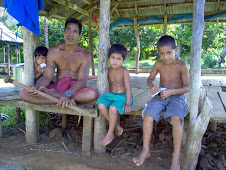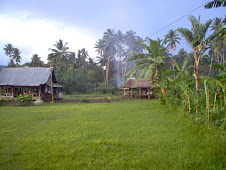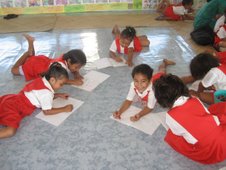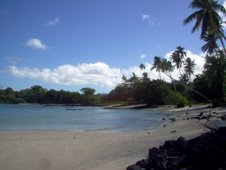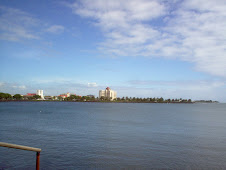
Friday, December 28, 2007
What is life like in my Samoan village?
Some of the men and women work outside of the village during the day – in offices or shops in Apia or as school teachers, etc. Most of the women stay at home and care for the family and many men also work on their family farms or fish instead of working elsewhere. Less than half of the families have vehicles. Most people ride the bus.
A general answer to the question would be “quiet.” The only sounds normally are the muffled roar of the surf on the fringing reef, which quickly becomes white noise, roosters crowing, dogs barking, birds singing, and usually music playing somewhere. On a daily basis people go about their normal activities. For the women this would be sewing, cleaning, cooking, weaving, child care, etc. Actually cooking takes up a great deal of time. Most people, including the family that I live with, still cook on open fires or in underground ovens with hot rocks in back of the main house (we have a one-burner propane cook top inside too). The men will go fishing or to their farm, which is up the mountain a little ways. That’s usually early in the morning or when it begins to cool off late in day. In the afternoon the women will often gather in the women’s committee house (an open fale) to talk, weave, play cards, or sleep.
Church and bingo are the two big activities of the week in the village. There are two churches in the village – Catholic and Congregational (the church of the missionaries which is descended from the Puritans, if I remember correctly). There are two church services on Sunday, not including Sunday School and the Youth Group meeting after church Sunday evening. There are usually one or two other church activities during the week too, such as choir practice or the women’s fellowship. Bingo is in the church hall and is a fund raiser for the church – very well-attended!
My life in the village will always be mostly unstructured, but is probably a little more so right now because I’m still settling in and not working very aggressively on any projects yet. But this is my “routine” at this point. I wake up about 6:30 and go for a walk on the road along the ocean in the cool of the day. Then I make breakfast etc. and figure out what I’m going to do for the day. If it’s Sunday I go to church. I usually go to the Congregational Church since it reminds me of the church where I went when I was young. My Samoan family also goes there. But every now and then I go to the Catholic service to make sure I continue to get acquainted with everyone in the village. It’s really important for us to go to church since it’s such an important part of village life. On Sunday there is nothing else to do since it’s a day of rest. We come home, eat a big meal and sleep and relax until the afternoon service. In addition to not working, on Sunday there is no swimming allowed and the young people don’t play rugby or volleyball like the usually do in the afternoons.
For these first few months in the village our primary “job” is to get to know the village and the people. So what I do each day varies from visiting the primary and secondary schools, going to village meetings of the chiefs or the women’s committee, to just studying the language. Sometimes I go and visit with the women in the committee house in the afternoon. And some days I just stay at home and read or write. I usually write some each day. Lately I’ve also been reading some sample proposals from other Peace Corps projects and making phone calls to set up appointments to get information about some of the proposed projects for the village. Nearly every afternoon I sit in the open fale next to the ocean and read or write, watch the fishermen or the children playing in the sea, and watch the sunset (always spectacular!). In the evening I read, watch dvd’s, play computer games, listen to Radio Australia (like NPR), etc. The family I live with has a TV, but there’s not much to watch.
After the holidays I’ll be starting to work in earnest on funding for the Learning Centre and an environmental project along the river bank and sea shore as well as some community gardens. It’s a process.
The Bamboo Cannon

Wednesday, October 31, 2007
Watching the Fishermen
This morning I also watched a mother and her children walking in the water inside the reef looking for sea cucumbers, clams, or other shell fish. When they spotted something they would go under the water to gather it up. The boy, about 7 or 8 years old, alternately pulled along, and floated on, a white plastic bucket in which they placed their catch. When I saw them go out, I thought it would be interesting and maybe fun to go with them some time, but they were out there for about two hours in the water and the direct overhead sun beating down. It is after all, dinner, not amusement.
Polynesia
All of the islands of Samoa put together (1,133 square miles) are about one-fourth of the size of the Big Island of Hawaii. The island that I live on here, Upolu, is roughly 50 miles long and 15 miles wide (about the same shape as the island of Molokai, which is about 30 miles long and about 6 miles wide).
The other major island, Savai’i, is also called the Big Island (I haven’t been there yet, but I’ll definitely go there). Samoans are convinced that Hawai’i is named for Savai’i, but historically everything I’ve read contradicts that. The Hawaiians came from the Marquesas between 300 and 1,000 CE with some later migrations from Tahiti. Samoa was settled about 3,000 years ago as part of the Polynesian migrations that began in Asia and continued throughout the Pacific. Polynesia is the term used for Pacific Islanders with similar ethnic and linguistic characteristics and close affinities to Malay people.
Samoa and Hawai’i are much alike in food, language, plants, and even the physical characteristics and society of the people. Someone in Hawai’i told me before I left to come here, that Samoa was like Hawai’i in the 1920’s or 30’s. That’s probably pretty close. Except for some of the modern conveniences like the internet, cell phones, and television.
Those same modern culture influences are some of the things challenging the country of Samoa today. The culture is still very religious, conservative, and modest. It’s difficult, especially for parents and teachers, when the children are exposed to American TV and movies, and god-knows-what on the internet. It’s not unlike some of the complaints that Islamic people have about Western countries. Religion here is kind of like that of Islamic nations. Not the theology of course, but the pervasiveness of it. It is not something that people do. It is who they are. It isn’t a place they go on Sundays, but an integral part of life everyday. Every public event includes a prayer to Atua (God). Nearly every article in the newspaper references Atua, even on the sport‘s pages. Everyday conversation and every meeting of any kind includes Atua. To eat a meal anywhere without saying “grace” is unthinkable. The country’s motto is “Samoa is founded on God.” And it clearly is. The missionaries who came in 1830 would be very pleased to know how successful they were.
Meeting of the Chiefs
Families form the village community. A village is largely a self-governing unit controlled by the village council composed of the matai. There is also a village mayor but his role is primarily as a liaison to the national government. The matai council makes all the decisions and set the rules for the village. For example, some of the rules in my village include no beer drinking in the village, no facial hair for men, and use of only traditional fishing methods.
Matai are divided into orators (talking chiefs) and chiefs. It is the duty of the orators to understand local history and tradition and to be able to use a special variation of the Samoan language only used on formal occasions. Maybe some other time I’ll write more about the history and traditions.
The chiefs are given positions of respect and participate along with the orators in decision making and village politics. Depending upon their status, they may sway the decisions made by the village council in one direction or another. Each village usually has one or two “high chiefs” whose rank exceeds that of the other matai.
Apart from obligations to the village, the most important duty of every matai is to look after the family (which may be dozens of people). The matai controls the family land and allocates its use. Family members serve the matai by cooking food and cultivating crops. In turn, they receive food, lodging, and money as needed. Family members living away from the matai (even in other countries) may be called upon to make contributions of food or money for church or family functions.
Although the matai system may resemble a feudal baron who gave serfs protection in return for the services, the system differs in one important respect. Family members have a strong say in who becomes the matai. Usually direct heirs are the first to be considered, but they are not always successful. Samoan’s have a saying, “O le ala i le pule o le tautua.” – “Service is the way to power.” Frequently one who has served the matai faithfully succeeds him. Discussions regarding matai titles are made on a consensual basis and sometimes difficult to reach. Occasionally a woman may be made a matai, but usually they are men.
Not all matai live up to the standards set by the system. Members of the family can express dissatisfaction and seek removal of the title, but this is rare. Like positions of leadership worldwide, some are active leaders, some are active followers, and some are along just for the ride.
So here’s what a matai council meeting looks like. The matai are seated cross-legged) on the floor of an open fale, a large one, maybe 40 or 50 feel long, which is the one designated for village council meetings. An “open fale” is a raised (two or three feet high) concrete foundation with posts from floor to ceiling averaging about ten inches in diameter and spaced about four feet apart. The sloping roof is galvanized metal nowadays, often painted a rusty red color, but was coconut frond thatch in the past. There is an overhang of a few feet all around.
The early birds get a post, but there are also designated seating arrangements. The high chief(s) sit at the end, and the highest orators are seated on one of the long sides. The rest of the matai are seated along the other side.
At the beginning of each meeting there is an ava ceremony. Some of you have heard of ava, or kava, as it’s called some places in the Pacific. Samoan ava is notoriously weak, so if you’ve experienced it elsewhere, it may have had more of a “punch” than Samoan ava. Ava is a drink made from the dried and pulverized root of a plant (piper methysticum). I hadn’t tasted it before I came to Samoa, although I had seen it in Hawaii. It tastes and looks kind of like dishwater. Not that I’ve made a practice of drinking dishwater, but I think have a general idea of what that tastes like! There is a specialized ritual which can be longer or shorter depending upon the occasion. For a matai meeting, there are three untitled young men (usually in their 20’s or 30’s) who sit on a fala mat, with one of the matai. They sit a few feet in front of the long row of matai whose backs are to the posts. The ava is in a wooden bowl that stands on little carved legs all around the edges of the bowl. One of the young men sits behind the bowl. Another serves the ava in half of a coconut shell. The third young man calls out the ceremonial ritual, directing the service of the ava in the appropriate order according to rank. I am served after the high chief (whom I also sit beside at the end of the fale).
When given the cup of ava, the proper procedure is to pour out a drop or two on the mat beside you while saying, “Lau ava lea le Atua.” – “God, here is your ava.” Then you say, “Soifua!” or “Manuia!” – which basically means “Good health to you!” Then you drink it and give the cup back to the server. You take only one drink. If you don’t finish it all in one drink, you toss the remainder in the cup out of the fale over your shoulder.
So besides the taste, what is ava like? I have only had these small sips (at five ceremonies since I’ve been here), but I’m told that if you drink a lot of it your tongue and lips will get sort of numb (it is part of the pepper family) and that it is a general relaxant. It’s not intoxicating like alcohol.
After the ava ceremony the chief orator begins the meeting with the appropriate honorifics and traditional language, always including thanks to God. And then they commence with the business of the day. Decisions are made by consensus and every opinion is heard and discussed. A simple majority is not used to make a decision. Whoever wishes to speak on a subject may do so (often at great length) and without interruption.
Wednesday, October 10, 2007
The First Weeks in Poutasi
I’m still challenged with understanding the spoken language much of the time, but that will come with practice. People in the village tell me all the time how well I speak Samoan.
For those of you familiar with the Hawaiian language, you know how subtle the nuances are, especially in Polynesian languages where the words are mostly vowels. For example:
ia (ē’-ah) means “he, she or it,” “these” or adds an emphasis which means “this one and no other” (Ia a’u? Ia oe! = Do you mean me? Yes, you!) Spoken with a rising tone and a glottal stop at the end, it means “very well then” or “all right then.”
‘ia (note the inverted comma which indicates a glottal stop making the i (ē) a short sound) means “in order to” or “yes.”
‘iā (note the macron indicating the vowel sound is held longer) can mean “in, at, on, for” depending on the context. ‘Iā is also the command given at the start of a race like, “Ready, set, go!”
and i’a means “fish.”
It's hugely contextual as you can tell!
My job for the first few months here is to get to know the village. I’m creating a village map and writing a report called the Village Situational Analysis which will compile info about the village such as population statistics (I’ll be doing a house-to-house survey), environmental overview, economic and agricultural assessment, health and school issues, community resources, etc. Although I have already been told about some of the projects that they would like me to do, this analysis will help to focus on possible projects and activities and the resources necessary to accomplish them.
So I’m not busy all day long. Actually, if I accomplish one Peace Corps related project each day I’m satisfied at this point. It may be attending a village meeting or church service or just studying the language. I’m sometimes torn between wanting to get started and charge ahead with some of the projects, and yet knowing that it’s best to understand the village, the personalities, the resources, etc. before I can expect to be successful. It’s important that it not be “my project,” but the village’s project.
So I’m doing a lot of reading, which I never get tired of, and writing. I started working on a garden this week. I’m learning to have more patience, which has never been one of my strengths.
Tuesday, September 4, 2007
The Move to Poutasi
It turns out that I will be living with a family in Poutasi across the road from the fale by the sea where I was originally supposed to live; the small fale will be available for me to work in, relax and read, and have meetings, etc. That will probably rescue me in the moments that I am discouraged. I have been over there nearly every day. The sea is soothing and calming in the way that it has been for millennia. The family that I am living with is very warm and welcoming.
With all of the anxiety I’ve been feeling about moving to a new village and meeting all the new people there – which is dissipating somewhat already – it’s good to remember how fortunate it is that I’m in such a beautiful place! I could be in a cold, dreary place or one that is hot and dusty and drab. This is exactly where I wanted to be. I am writing this on my laptop and will save it to my flashdrive to take to town to post on my blog. At this moment I’m sitting in the fale by the sea listening to the birds twittering in the nonu bushes, kingfishers, I think, and to the constant chattering of the coconut palm fronds as they rise and fall in the breeze. I hear the steady roar of the surf as it crashes over and over the fringing reef of the island, maybe a half mile away (I’m not good at judging distances, especially over water.). The small waves reaching the shore about 20 feet in front of me lap a continuous beat of their own. The pounding surf sounds like a waterfall upstream, ebbing and flowing slightly, but never stopping, with the small waves like a babbling brook beside me. The sound of the surf is faint enough that one can easily not hear it because you quickly become accustomed to the “white noise.” But it is always there, loud enough to be clearly heard, even from my room in the house when I stop and listen.
The ocean just about 20 feet in front of me is varying shades of blue and aqua. The Samoan word for the color blue is lanumoana, which literally means the color of the deep ocean. It is clean and clear and only about waist deep in most places all the way out to the reef. A couple of mornings I have gone for a short swim after my morning walk.
I’m looking between the palms in front of the fale at Nuu Safee Island. The island is owned by the village. It is a small uninhabited island that one can go to for a day trip by boat (I haven’t yet, but I’m looking forward to it). Sometimes visitors “rent” the island and stay there for a few days. It is the postcard version of a Pacific Island fringed by coconut palms with a wide white coral beach. The sun is slowly setting leaving a shining path on the sea. As it sinks behind the clouds, the forest below on the horizon becomes a silhouette with the tallest palms in stark relief above the tree canopy. Soon the brightness will fade to pinks and oranges as it disappears for the night. Behind me the tops of the mountain ridges are covered with clouds whose edges look like puffs of cotton. I suspect it’s raining at the summit.
There is a cool breeze blowing my troubles away – blowing them out to sea so that I can replace them with loving, calm, serene, and confident thoughts that I am being sent from my family and friends back home. Fa’afetai!
Leaving Manunu
It is absolutely amazing to realize that we have nearly completed our training, and be sworn in as official Peace Corps volunteers on Wednesday. It has been tough, but has gone by so quickly. We are in for a big change that will be perhaps more challenging than what we’ve experienced thus far. Going to our new villages on August 23rd and adapting to a new lifestyle - no more structured training calendars, meeting a whole village of new people, and starting the "job" part of our Peace Corps experience will be difficult in many ways. Nonetheless, we have gotten this far and have been given tools to use. That’s what the sometimes grueling training has been for.
Last Sunday morning the congregation of the church in our training village began to say goodbye to us. I read in Samoan, a prayer of thanks. Compared to the few words I was able to say on that very first Sunday here, even I am impressed with my abilities. (I passed our final language test at the advanced level last week - I was pleasantly surprised.) Like on our first Sunday, when we we all went to the front of the church to be welcomed, we did that again. Only this time we knew everyone who gave us a hug or a lei. It was a beautiful and moving service and I couldn’t help but shed a few tears.
Of course none of this could have happened without the village of Manunu. (Each new group of volunteers goes to a different village in Samoa for their training village.) We are each going to desperately miss our families here. I have been given an incredible honor. Baby Urima will also be given the name of Donna. I am nearly moved to tears each time I think of it. All the rest of her life she will know that she was named for this palagi (a generic term for white person - not used derisively) who once came to live with the family for a few short weeks.
We have been told by the trainers and current PC volunteers that we are having a very special experience in Manunu. Never before has a Peace Corps training group been so warmly welcomed into the whole community and made a real part of the village. We have been part of the lotu (church services), had sivas (dances) thrown just for us, and I think our goodbye fiafia (village celebration with traditional dance, etc.) next week will be a hard act to follow. It is a physically beautiful village nestled in the mountains. The traditional village structure with the homes in a circular pattern and the malae in the middle (grassy "village square" where the young people play rugby and soccer and village gatherings are held) make not only a picturesque setting, but an remarkable social network of families, Samoan style. They have literally and figuratively surrounded us with their love and kindness.
The village itself has also told us how much we will missed and that we have made a difference by being here. This week, one of the chiefs told us that for some of the people in Manunu this has been one of the happiest times of their lives. Amazing!
August 18, 2007
First came the women of the village walking across the malae singing in their matching blue puletasi (dresses) with red flowers. Some had flowers in their hair, others had fragrant leis around their necks. Their beautiful voices blended together in harmony and wafted across to us on the cool early morning breeze. The elder men of the village laid the fala papa (woven mats) on the grass across from us and took their places according to rank. The high orator of the village began to speak with his ceremonial whisk over his shoulder and his talking staff held firmly in his hand. Although at this point I can understand some of the language, one didn't need to know any of the words to understand the honor that was being bestowed upon us. Then came six young men of the village carrying a bamboo platform covered with banana leaves with a huge whole roasted pig cooked that morning in the umu (underground oven). Next other young men of the village brought woven palm leaf baskets with smaller roasted pigs and other food. And then they laid banana leaves on the grass in front of us and four young men came walking toward us with the head and front and hind quarters of a just-butcherd cow slung over their shoulders with blood running down their backs they laid it in front of us. They gave us a cow! In local tradition that is a tremendous honor. And then the women brought out expertly woven fine mats and laid them in front of us.
This small group of sixteen people who have arrived in the country only three months ago to do our best to help where we can have been so blessed to be in the village of Manunu for these past few weeks. Each of us has acquired a new Samoan family and an entire community to call our home whenever we want to return.
We sat cross-legged, Samoan style on our fala mat, awestruck with the gratitude that was begin expressed to us, when it is we who cannot express enough gratitude to the families that took us into their homes, welcomed us with open arms, taught us the Samoan language and the Samoan way of life, and provided us with food, shelter and alofa for seven weeks. To say that none of us, the people of Manunu or the Pisikoa, will ever forget this experience of the past few weeks is an understatement I am sure. The people of Manunu will tell the story over the years about the palangi who lived with them once upon a time with whom they laughed and played and who they took into their hearts. And each of us will have stories to tell our grandchildren about how we once lived in a Samoan village and taught them how to play softball, sang in the church choir, danced the siva, killed a chicken for dinner, climbed a coconut tree, had a beau with whom we sat and talked under the stars, made coconut cream from a fresh coconut, swam in the pool by the waterfall, lived in a little thatched-roof hut, had a chicken lay an egg at the foot of the bed, walked each morning in the dew-laden grass to the open fale for classes each day, or had the honor of a holding a precious baby girl in your arms who was named for you.
_________________________________________
And this is just beginning! Next week we each go to a new village to begin our "real" Peace Corps experience.
Sunday, August 5, 2007
I visited my new village
We leave to go back to Manunu later today (limited internet and phone access during that time). Only two weeks until we are finished with training and become official volunteers! We are kept so busy in classes all day and have very little free time. It will be a big adjustment to be dropped off in a village I don't know with no structured schedule. My "job" for the first few months is to get to know the village and the people.
Sunday, July 29, 2007
We got our village assignments!
I'm back in Apia after being in our "training village" for three weeks. There is no internet access there so while back in Apia I'm trying to catch up. We got our assignments this week for the villages we will be living in for the next two years when we finish our training. I will be living in Poutasi. It is a small village of about 400 people on the south side of the
I’ll be going to the village for a visit later this week and will know a lot more about it then. I will take some photos and hopefully put them on my web page before I go back to Manunu next Sunday for two more weeks. I do know that I will living in a house of my own right on the beach. Sweet! The village wants gardening, fishing, and tourism projects. I don’t know anything about fish, but I could learn enough to help perhaps. And there are other volunteers who do have marine science background. Oh, and they want a new school building! The main thing I could do on that would be to help them apply for a grant to get some funding. In two years as volunteers we can only do so much, so I’ll see what happens. Sometimes they say they want something and it turns out that there’s something else that gets accomplished instead that they didn‘t identify. Our first few months in the village our job is to integrate and learn to know the village and the people, and then identify projects we might be able to do.
I’m having a great experience so far! I think those first few days in my new village will be somewhat of an adjustment. The sixteen of us have been together as a group for training since June 4th, so we’ve bonded and gotten to know each other well. And we’ll definitely be needing to use our language skills! Learning the language is going pretty well. I’m doing better than many in the group. Probably partly because it is very similar to the Hawaiian language and also because I’m trying very hard and am committed to being as fluent as possible.
Monday, July 2, 2007
It's July Already!
July 1, 2007
We are back in Apia after our first two weeks in Manunu, our training village. It has been an intense, but good experience. We are here in Apia for one week (well, sort of - more on that later) and then we go back to Manunu for three weeks. I think we are all having a very positive experience thus far, language challenges, strange food encounters and all. The village of Manunu is beautiful. It's inland, but there is a river with a waterfall and natural pool to swim in nearby.
I have come to know and like my family and I expect that I will want to keep in touch with them as long as I am here in Samoa. I fit in very well being in the pastor's home. I can call up all my early life experiences. There is a lot of church. We have Sunday morning service of course, and Sunday afternoon service at 4:00 pm. And every evening there is prayer time and Bible study at 6:00 pm. It all helps to learn the language though.
On that note, the language learning is going well. I got a good grade on my first oral competency exam (interview). I just need to continue to practice and memorize. I don't totally understand the grammar, but bits and pieces are falling in place. I find myself getting to learning plateaus and then having a break through of sorts when something clicks and then I can go to the next level.
A typical day starts with a walk down the road if I get up early enough. It doesn't get light until 6:30 am. Then breakfast and get ready for class. Class for the day starts at 8:00. Each day of class is language and/or work and life classes, medical classes, or safety and security classes. We have a half hour tea break morning and afternoon and an hour and a half for lunch. Class ends as 5:30 pm. Then there is homework to do each night. And studying vocabulary and preparing for tests.
On Tuesday this week we go on Volunteer Visits. Meaning we go to visit current volunteers in their villages for three days. Then back to Apia on Friday and back to Manunu on Saturday. I'm going to Tafitoala. The village is on the south side of the island at the beach (Apia is on the north side).
Thursday, June 14, 2007
June 6, 2007
Arrived in Samoa for my Peace Corps adventure safe and sound. I'm ready to get started!
June 9, 2007
There's a lot to learn and take in. We are in a classroom setting each day, albeit outdoors. Actually in the courtyard of the hotel. There is some shade and ceiling fans, but it still gets hot and sticky part of the day. I don't know the actual temperature or humidity. It seems a bit hotter and more humid than Hawaii, but I'm not often outdoors at sea level there. There has been some rain overnight, but I haven't heard it. In a few days we go inland to our training village and the weather will no doubt be somewhat different there depending on the altitude.
I'm still feeling pretty good about learning the language. It is a lot like Hawaiian. It's mostly learning the proper accent and inflection and of course vocabulary, vocabulary, vocabulary. We haven't gotten to sentence structure yet. I am determined to give it my best effort to be able to speak as fluently as possible.
I found out that I am supposed to work on an agricultural project as I was originally told. Don't know any more than that though.
June 10, 2007
Today we went to Matareva Beach - a picture perfect spot where we went snorkeling and played in the ocean. There is a reef that keeps the surf from being too strong. There were fish to see and I saw a cool blue star fish. Maybe it was just the beach we were at, but there weren't as many fish or fish as large as I'm used to in Hawaii. It was a lovely day though and I really enjoyed seeing the countryside and the villages along the way. We went on a bus across the island. It's Sunday so people were out on the roads walking to church in their white clothes - very picturesque. Tomorrow back to work in the classroom.
Friday, May 25, 2007
Sail Away
Twenty years from now you will be more disappointed by the things that you didn’t do than by the ones you did do. So throw off the bowlines. Sail away from the safe harbor. Catch the trade winds in your sails. Explore. Dream. Discover. Mark Twain


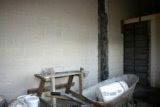
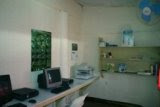
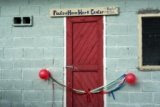
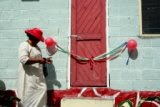
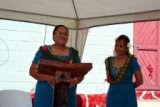
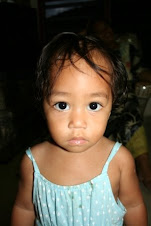
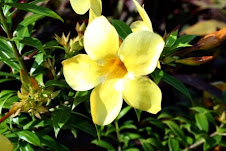
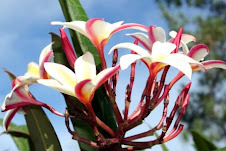
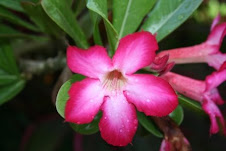

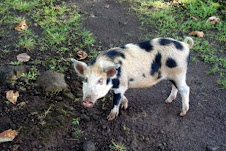

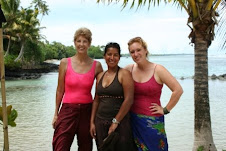

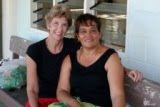

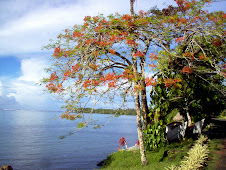
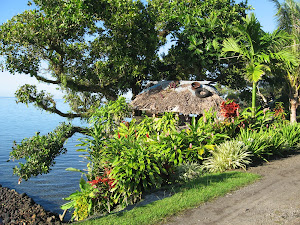
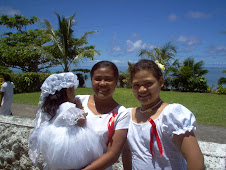
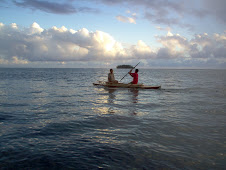

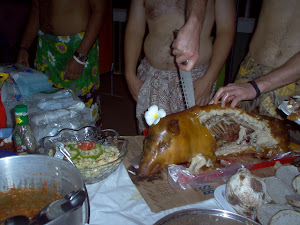
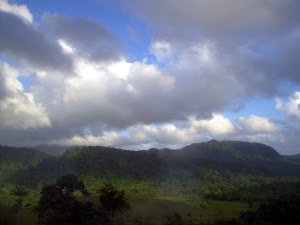
.jpg)
